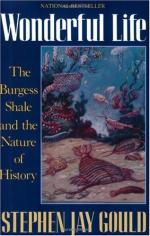
|
| Name: _________________________ | Period: ___________________ |
This test consists of 15 multiple choice questions and 5 short answer questions.
Multiple Choice Questions
1. What did Marella have that no trilobite shared?
(a) Two backs.
(b) Large incisors.
(c) Appendages.
(d) Twenty ligaments.
2. What kinds of versions does the story of the Burgess Shale's discovery have?
(a) A old, more accurate version and a newer, less accurate version.
(b) Two of more or less the same version.
(c) A newer, less accurate version and an older, more accurate version.
(d) An old, less accurate version and a newer, more accurate version.
3. What did Gould describe as characteristic of arthropods?
(a) Noodly proboscis.
(b) Hard, body shell.
(c) Odd segmented trunk.
(d) Bodily appendages.
4. Where was Opabinia quoted to belong?
(a) Among the crustaceans.
(b) In the third genus.
(c) With the arthropods.
(d) Nowhere among the known animals.
5. What bizarre features does Opabinia possess?
(a) Frontal nozzle and five eyes.
(b) Twenty limbs.
(c) No nose and three eyes.
(d) Eight noses and four eyes.
6. What was Opabinia's frontal nozzle not?
(a) A second mouth.
(b) Part of its head.
(c) A proboscis.
(d) A carapace.
7. What did the new methods Whittington and his team adopted help them do?
(a) Organize the fossils.
(b) Transport the fossils.
(c) Study the fossils.
(d) Recast the fossils.
8. How many levels are there in the taxonomy of life?
(a) Hundreds.
(b) Several.
(c) Few.
(d) None.
9. What did Whittington shockingly find after the dissection of Opabinia?
(a) A baby Opabinia.
(b) Nothing underneath the carapace at all.
(c) Two hearts.
(d) Another complete, yet smaller Opabinia.
10. How many general stages of fauna are between the two faunas both eukaryotic and of the Burgess Shale?
(a) Two.
(b) Five.
(c) Three.
(d) Four.
11. What was Whittington's first monograph about?
(a) Goroia.
(b) Marrella.
(c) Opabinia.
(d) Splendens.
12. What did Whittington use to dissect the carapace of Opabinia?
(a) New tools.
(b) New methods.
(c) New stringents.
(d) Old tools.
13. Which genus was Whittington focused on classifying in Chapter Three?
(a) Minillera.
(b) Hartoll.
(c) Marrella.
(d) Splendens.
14. What could Whittington not classify Marella with?
(a) Any taxonomic genus.
(b) Any species or phyla.
(c) Any known group of vertebrates.
(d) Any known group of arthropods.
15. What kind of drama does Gould wish to recount that led to rejecting Walcott's interpretation?
(a) Intellectual.
(b) Physical.
(c) Spiritual.
(d) Emotional.
Short Answer Questions
1. What cost comes with accepting Gould's picture of human evolution?
2. What part did Whittington dissect of Opabinia?
3. When was the famed "death of the dinosaurs?"
4. Of Whittington's team, who was more methodologically conservative?
5. Why did Whittington dissect Opabinia?
|
This section contains 412 words (approx. 2 pages at 300 words per page) |

|




